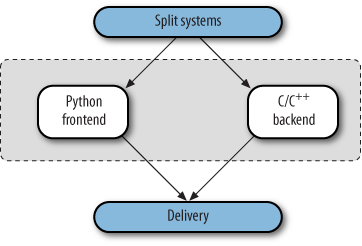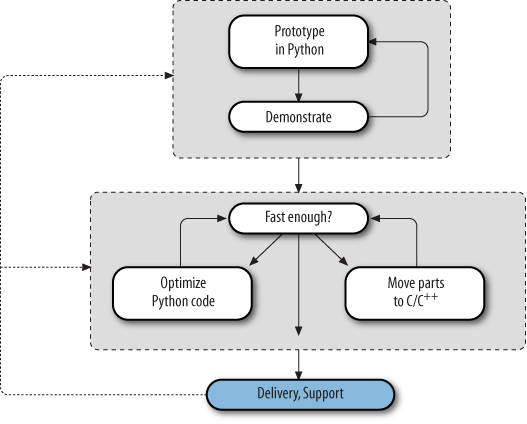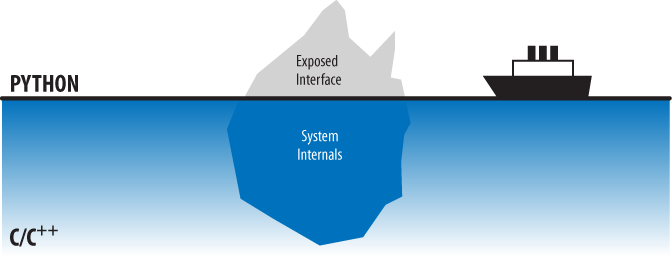Programming Python (203 page)

Back to our
original question: how can the act of writing software be
made easier? At some level, Python is really “just another computer
language.” It’s certainly true that Python the language doesn’t represent
much that’s radically new from a theoretical point of view. So why should
we be excited about Python when so many languages have been tried
already?
What makes Python of interest, and what may be its larger
contribution to the development world, is not its syntax or semantics, but
its worldview: Python’s combination of tools makes rapid development a
realistic goal. In a nutshell, Python fosters rapid development by
providing features like these:
Fast build-cycle turnaround
A very high-level, object-oriented language
Integration facilities to enable mixed-language
development
Specifically, Python attacks the software development bottleneck on
four fronts, described in the following sections.
Python’s development cycle is dramatically shorter than that of
traditional tools. In Python, there are no compile or link steps—Python
programs simply import modules at runtime and use the objects they
contain. Because of this, Python programs run immediately after changes
are made. And in cases where dynamic module reloading can be used, it’s
even possible to change and reload parts of a running program without
stopping it at all.
Figure 21-1
shows Python’s
impact on the development cycle.

Figure 21-1. Development cycles
Because Python is interpreted, there’s a rapid turnaround after
program changes. And because Python’s parser is embedded in Python-based
systems, it’s easy to modify programs at runtime. For example, we saw
how GUI programs developed with Python allow developers to change the
code that handles a button press while the GUI remains active; the
effect of the code change may be observed immediately when the button is
pressed again. There’s no need to stop and rebuild.
More generally, the entire development process in Python is an
exercise in rapid prototyping. Python lends itself to experimental and
interactive program development, and it encourages developing systems
incrementally by testing components in isolation and putting them
together later. In fact, we’ve seen that we can switch from testing
components (unit tests) to testing whole systems (integration tests)
arbitrarily, as illustrated in
Figure 21-2
.

Figure 21-2. Incremental development
Python’s very high-level nature means there’s less for us to
program and manage. The lack of compile and link steps isn’t really
enough to address the development cycle bottleneck by itself. For
instance, a C or C++ interpreter might provide fast turnaround but would
still be almost useless for rapid development: the language is too
complex and low level.
But because Python is also a simple language, coding is
dramatically faster, too. For example, its dynamic typing, built-in
objects, and garbage collection eliminate much of the manual bookkeeping
code required in lower-level languages such as C and
C++
. Since things such as type
declarations, memory management, and common data structure
implementations are conspicuously absent, Python programs are typically
a fraction of the size of their C and C++ equivalents. There’s less to
write and read, and there are fewer interactions among language
components, and thus there is less opportunity for coding errors.
Because most bookkeeping code is missing, Python programs are
easier to understand and more closely reflect the actual problem they’re
intended to address. And Python’s high-level nature not only allows
algorithms to be realized more quickly but also makes it easier to learn
the language.
For OOP to be useful,
it must be easy to apply. Python makes OOP a flexible tool
by delivering it in a dynamic language. More importantly, its class
mechanism is a simplified subset of C++’s; this simplification is what
makes OOP useful in the context of a rapid-development tool. For
instance, when we looked at data structure classes in this book, we saw
that Python’s dynamic typing let us apply a single class to a variety of
object types; we didn’t need to write variants for each supported type.
In exchange for not constraining types, Python code becomes flexible and
agile.
In fact, Python’s OOP is so easy to use that there’s really no
reason not to apply it in most parts of an application. Python’s class
model has features powerful enough for complex programs, yet because
they’re provided in simple ways, they do not interfere with the problem
we’re trying to solve.
As we’ve seen earlier in this book, Python’s extending and
embedding support makes it useful in mixed-language systems. Without
good integration facilities, even the best rapid-development language is
a “closed box” and is not generally useful in modern development
environments. But Python’s integration tools make it usable in hybrid,
multicomponent applications. As one consequence, systems can
simultaneously utilize the strengths of Python for rapid development and
of traditional languages such as C for rapid execution.
While it’s possible and common to use Python as a standalone tool,
it doesn’t impose this mode. Instead, Python encourages an integrated
approach to application development. By supporting arbitrary mixtures of
Python and traditional languages, Python fosters a spectrum of
development paradigms, ranging from pure prototyping to pure efficiency.
Figure 21-3
shows the
abstract case.

Figure 21-3. The development mode “slider”
As we move to the left extreme of the spectrum, we optimize speed
of development. Moving to the right side optimizes speed of execution.
And somewhere in between is an optimum mix for any given project. With
Python, not only can we pick the proper mix for our project, but we can
also later move the RAD slider in the picture arbitrarily as our needs
change:
- Going to the right
Projects can be started on the left end of the scale in
Python and gradually moved toward the right, module by module, as
needed to optimize performance for
delivery
.- Going to the left
Similarly, we can move strategic parts of existing C or C++
applications on the right end of the scale to Python, to support
end-user programming and customization on the left end of the
scale.
This flexibility of development modes is crucial in realistic
environments. Python is optimized for speed of development, but that
alone isn’t always enough. By themselves, neither C nor Python is
adequate to address the development bottleneck; together, they can do
much more. As shown in
Figure 21-4
, for instance,
apart from standalone use, one of Python’s most common roles splits
systems into frontend components that can benefit from Python’s ease of
use and backend modules that require the efficiency of static languages
such as C, C++, or FORTRAN.

Figure 21-4. Hybrid designs
Whether we add Python frontend interfaces to existing systems or
design them in early on, such a division of labor can open up a system
to its users without exposing its internals.
When developing new systems, we also have the option of writing
entirely in Python at first and then optimizing as needed for delivery
by moving performance-critical components to compiled languages. And
because Python and C modules look the same to clients, migration to
compiled extensions is transparent.
Prototyping doesn’t make sense in every scenario. Sometimes
splitting a system into a Python frontend and a C/C++ backend up front
works best. And prototyping doesn’t help much when enhancing existing
systems. But where it can be applied, early prototyping can be a major
asset. By prototyping in Python first, we can show results more quickly.
Perhaps more critically, end users can be closely involved in the early
stages of the process, as sketched in
Figure 21-5
. The result is systems that more
closely reflect their original
requirements.

Figure 21-5. Prototyping with Python
In short, Python is really more than a language; it implies a
development philosophy. The concepts of prototyping, rapid development,
and hybrid applications certainly aren’t new. But while the benefits of
such development modes are widely recognized, there has been a lack of
tools that make them practical without sacrificing programming power. This
is one of the main gaps that Python’s design fills:
Python
provides a simple but powerful rapid development language, along with the
integration tools needed to apply it in realistic development
environments
.
This combination arguably makes Python unique among similar tools.
For instance, Tcl is a good integration tool but not a full-blown
language; Perl is a powerful system administration language but a weak
integration tool. But Python’s marriage of a
powerful
dynamic language and integration
opens the door to fundamentally faster development modes. With Python,
it’s no longer necessary to choose between fast development and fast
execution.
By now, it should be clear that a single programming language can’t
satisfy all our development goals. Our needs are sometimes contradictory:
the goals of efficiency and flexibility will probably always clash. Given
the high cost of making software, the choice between development and
execution speed is crucial. Although machine cycles are cheaper than
programmers, we can’t yet ignore efficiency completely.
But with a tool like Python, we don’t need to decide between the two
goals at all. Just as a carpenter wouldn’t drive a nail with a chainsaw,
software engineers are now empowered to use the right tool for the task at
hand: Python when speed of development matters, compiled languages when
efficiency dominates, and combinations of the two when our goals are not
absolute.
Moreover, we don’t have to sacrifice code reuse or rewrite
exhaustively for delivery when applying rapid development with Python. We
can have our rapid development cake and eat it too:
- Reusability
Because Python is a high-level, object-oriented language, it
encourages writing reusable software and well-designed
systems.- Deliverability
Because Python is designed for use in mixed-language systems,
we don’t have to move to more efficient languages all at
once.
In many scenarios, a system’s frontend and infrastructure may be
written in Python for ease of development and modification, but the kernel
is still written in C or C++ for efficiency. Python has been called the
tip of the iceberg in such systems—the part visible to end users of a
package, as captured in
Figure 21-6
.

Figure 21-6. “Sinking the Titanic” with mixed-language systems
Such an architecture uses the best of both worlds: it can be
extended by adding more Python code or by writing C extension modules,
depending on performance requirements. But this is just one of many
mixed-language development scenarios:
- System interfaces
Packaging libraries as Python extension modules makes them
more accessible.- End-user customization
Delegating logic to embedded Python code provides for onsite
changes.- Pure prototyping
Python prototypes can be moved to C all at once or
piecemeal.- Legacy code migration
Moving existing code from C to Python makes it simpler and
more flexible.- Standalone use
Of course, using Python all by itself leverages its existing
library of tools.
Python’s design lets us apply it in whatever way makes sense for
each project.
